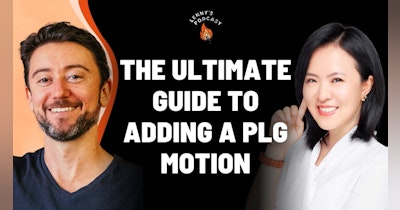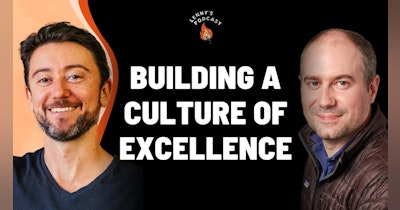Janna Bastow is a former product manager and is currently the CEO and co-founder of ProdPad. She also co-founded Mind the Product, a community for PMs, which has grown to 300,000 members across the world.
Like many product managers, Janna accidentally fell into the role early in her career. She worked her way up to lead Product at a startup in London. But Janna saw a need for tools built specifically for product managers, since there wasn’t much out there, so she co-founded ProdPad to fill that gap. Mind the Product has become the largest community of product managers in the world.
You can also see the episode transcript and Janna’s references.
How the community evolved at Mind the Product ▶️
The community formed naturally from a group of product people who wanted to learn together, rather than a deliberate plan.
We figured if we got together with some other product people and started chatting it through, we’d all learn together.
Other principles that helped Janna build the largest product community in the world:
Consistency is key: Regularly hold events, meetings, or discussions to keep the momentum going and maintain engagement within the community. For instance, Janna sets up monthly meetups or annual conferences.
Involve the right people early on: Start by including those who embody the values and goals of the community you want to create. They can help set the tone and direction for future growth.
Expand your network: Look beyond your immediate circle to bring in diverse perspectives and expertise. Reach out to new contacts or ask existing members for referrals to find speakers or blog contributors, enriching the community’s knowledge base.
Why it’s hard to run a conference
- It’s not lean, making it difficult for product folks who prefer lean and iterative approaches. If something screws up, you can’t fix it. You have to wait until the next year.
- For example: Once they ordered food, and it wasn’t enough for everyone because the caterers underdelivered. They ended up sending cash cards to the attendees saying, “Here, let’s make it up to you.”
- When things go wrong in conferences, the costs escalate quickly.
- Say, when a speaker cancels last-minute. You’ve already paid for their business-class flights, and you’ve got to find another speaker, so this costs thousands.
How Janna developed her storytelling and presentation skills ▶️
By being part of Mind the Product, Janna has gotten to watch thousands of talks, allowing her to develop a taste for good presentation skills. Things that helped her become a better speaker:
- Get coaching. Having an outside perspective helps make your content and delivery so much stronger. A coach can catch little things you miss and help you connect with your audience. For Janna, her coach helped her with posture, delivery, and even the phrasing of words.
- Record yourself and listen back. It’s uncomfortable but so helpful. You pick up on little things to improve and get much more comfortable hearing yourself speak. By the time you present, you know your material inside and out.
- Focus on your story and message first. Don’t just dive into making slides. Start with your narrative—figure out what you really want to say first and then fit that into the deck. The slides should enhance your message, not drive it.
How to fight performance anxiety onstage ▶️
- Try power posing. Janna does this right before going onstage at major events, and it really works for her. Stand with your hands on your hips and shoulders back. It releases feel-good chemicals in your body that pump up your confidence.
- Lenny: I think there’s also when you raise your hands up and you’re like Superman…
- Get familiar with the stage beforehand. If you get a chance to do a tech check, walk around the stage and look out at the audience. Imagine the room filled with people. This can help you feel more at ease when it’s showtime.
- Look for your fans. While presenting, find the friendly faces in the crowd who are nodding along. Speak directly to them, make eye contact, and connect. Those fans will give you energy, you’ll feed off each other, and before you know it you’ve given an engaging talk and made a real connection.
The limitations of traditional timeline roadmaps ▶️
Janna initially followed the traditional timeline roadmap format, like a Gantt chart, which focused on features and due dates. However, things never seemed to go as planned and they couldn’t deliver everything on time.
Source
Roadmaps give you certainty but set you up for failure because of their inherent structure; they have a list of features and due dates but assume:
- The effort and timeline for each feature. This might be easier for projects that have been broken down into smaller chunks, but the further down the list you go, the less clarity you’ve got.
- Nothing else is going to disrupt your timeline. No new changes in the market, no new competitors, no new fresh ideas from the customers, no need for iteration.
- Each of these features actually deserve to exist. Each feature will work as soon as it is launched.
What could go wrong? You end of creating these made-up release dates that force your developers to crunch and release on time. It gives your sales and customers expectations that you can’t meet while usually being blind to new opportunities. You end up building the wrong things.
Is there a better way?
Janna’s now/next/later framework ▶️
Your roadmap is a tool to help you iterate and learn at the product strategy level. It’s a prototype for your strategy.
A prototype is essentially a way of checking your assumptions. At the feature level, you’d prototype by doing a design and sharing it with somebody and saying, “Here’s a mockup of the feature that I’m trying to build. What do you think?” And you gather feedback.
The real value lies in the roadmapping process, not the end roadmap itself. By sharing early assumptions with your team and customers, you ensure you’re on the right path together.
So instead of a timeline, think in terms of these three buckets.
- Now: You are granular about your focus and scope. This is the thing you want to build right now.
- Next: This focuses on what’s to come.
- Later: This is much less about specific initiatives and more about outlining the problems that you need to solve in order to fulfill your vision.
Many companies have adopted the framework and had it lead to good outcomes. The now/next/later framework offers:
- Flexibility: You can easily shift priorities and adjust your focus without stressing over specific due dates for every task, thereby adapting to uncertainties smoothly.
- Clear vision of goals: You can focus on what’s important right now while also keeping an eye on what’s coming up next and planning for the future.
- Better communication: Everyone can see what tasks are current, near-term, and further down the road, which helps everyone stay on the same page and understand how their work contributes to the bigger picture.
- Strategic approach to planning: Instead of getting bogged down by details and deadlines, you can focus on your goals and overall product vision. This helps your team make more informed decisions and prioritize tasks effectively.
Why soft launches are important ▶️
Regular communication: Maintain frequent communication with your team to ensure everyone is aware of upcoming tasks and timelines. This way, they’ll know that items in the “now” column are just weeks away, not months.
Soft launch vs. hard launch: Separate the soft launch (when developers release a product) from the hard launch (when marketing actively promotes it). This allows marketers to work with a functional, working version of the product and gather valuable feedback, testimonials, and media assets for a more effective launch.
Streamlined workflow: By separating soft and hard launches, development and marketing teams can work more efficiently, with developers focusing on their next project while marketing handles the hard launch. This way, both teams can progress without unnecessary stress or delays.
What great product teams are doing well ▶️
- A focus on discovery. The ability to spend time in discovery, asking questions of customers and constantly being able to iterate based on that.
- Psychological safety. The teams who are able to question each other, speak up when they see that things are wrong, and question what’s going on at the senior level generally have a good sense of what’s going on across their business.
- Retrospectives. Asking hard questions like “What are we doing that’s working? What are we doing that’s not working? Are we allowed to go change it?” makes you iterate faster.
How to shift the culture at larger companies ▶️
This is super-hard to do, though the start is to chip away at it gradually rather than tackle every change at once, and often with a small pocket of the organization that can, if successful, create a ripple effect and influence other parts of the org.
Big companies often prioritize stability and quarter-on-quarter growth, which may work well for the stock market but can make them vulnerable to startups. If these larger organizations don’t adapt and innovate, they risk losing their competitive edge and getting left behind in the market.
For instance, HSBC faces competition from fintech startups like Starling Bank, which may chip away at their market share. Recognize the need to adapt and innovate to counter these threats and stay relevant in the long run.
How do you come up with a product vision?
Janna uses the elevator pitch template from Geoffrey Moore’s book Crossing the Chasm:
This is a human edited summary of the podcast episode with Janna, by Gaurav Chandrashekar (@cggaurav, productscale.xyz). To listen to the full episode, go here.








